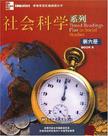中学生拓展课程系列
出版时间:2008-7 出版社:上海外语教育出版社 作者:曹娟,方力 注 页数:101
前言
阅读既是理解和吸收语言文化信息的重要手段之一,又是语言文化信息的最便捷的输入源。我国教育部新制定的全日制义务教育和普通高级中学《英语课程标准》对学生的阅读技能从三级到九级提出了明确的要求。在目前国内外的各种英语测试中,阅读理解所占的比重越来越大。为此,我们特向你推荐“中学英语拓展阅读丛书”(Timed Readings Plus)。本丛书含有以下3个子系列:社会科学(Social.Studies)、自然科学(.Science)及数学(Mathematics),由上海外语教育出版社从美国McGraw Hill Glencoe公司引进出版。社会科学和自然科学各有10个分册,社会科学每册有24课,自然科学每册有25课,每课两篇阅读材料;数学有5个分册,每册有15课,每课两篇阅读材料。本丛书语言地道,知识面广,信息量大,能有效训练学生的阅读理解能力,提高他们的阅读速度。每课的第一篇阅读材料篇幅长400单词左右,侧重训练学生的快速阅读能力;阅读理解题则主要检查学生是否能在快速阅读后掌握阅读材料中的事实和材料所传达的思想。每课中的第二篇阅读材料较短,着重训练学生的阅读技巧,如:从上下文中猜测生词的含义,找出作者的观点,得出中心思想,排列事件顺序,推断作者的论点等。因此,我们认为它是一套训练学生阅读速度及阅读理解能力并能同时开拓他们视野的拓展型丛书,适合外国语学校初二及以上年级学生和非外国语学校高中学生课内、外使用。 怎样使用本系列丛书呢?我们有以下的一些阅读策略供大家参考。 1.阅读时,要集中注意力。 2.用一分钟阅读标题,并思考以下问题:我是否了解这一话题?我从这个话题中能学到什么?这个话题引起了我怎样的思考? 3.重点阅读文章第一句和最后一句,因为第一句和最后一句往往是作者提出自己观点和总结全文观点的关键句子。 4.快速阅读全文以获得材料所传达给你的信息。如遇到含有姓名、日期或数字等的内容,你应该放慢速度,以便记住这些内容。 怎样才是一个快速阅读者?
内容概要
遨游知识天地学习地道英语 你听说过环境建筑学吗?你知道转基因技术基于怎样的原理吗?我们每天点击的互联网是在哪种巧合下诞生的?欧洲中世纪城堡中一天的生活是怎样的?中国古代的造纸术分哪几个步骤?你一定想知道这些问题的答案吧。翻开这套"中学英语拓展阅读丛书",你就走进了一个五彩斑斓的奇妙世界。 《中学英语拓展阅读丛书》由外教社从美国著名出版机构麦格劳一希尔(McGraw Hill)公司引进,语言地道,知识面广,信息量大,是一套既注重培养学生英语阅读能力,又致力开阔他们视野的拓展型丛书。整套书编写理念先进,编排设计科学,难度逐级递升,既适合外国语学校及外语特色学校初二至高三年级的学生使用,也适合普通中学同等水平的学生使用。 我们期盼你在趣味盎然的阅读环境中培养阅读能力,邀游知识天地,学习地道英语。
书籍目录
致学生致老师1 A States of the Middle Atlantic Region1 B William Penn's Legacy2 A The Shy Angel2 B A Woman with a Flare for Success3 A Australian Aborigines:Living with a Land and a Legacy3 B Early Tools and Toolmaking4 A John F. Kennedy: Soft on Civil Rights?4 B Bringing History Back to the White House5 A Film and the Depression5 B Edison's Kinetoscope and the Birth of the Movies6 A The Genius of Ancient Rome6 B Augustus and the Pax Romana7 A Haves and Have-Nots in the 1950s7 B Homelessness in the Twenty-First Century8 A I Do, I Do-In Any Tradition8 B Making a Match: The Role of the Shadchan9 A The Changing Roles of American Women9 B Helen Keller's Activism10 A The Russians and the Aleuts10 B The Aleuts of the Pribilofs11 A Map Projections11 B Mercator If by Sea12 A The Electoral College12 B Andrew Jackson and the Electoral System13 A A Navel Journey13 B Hazardous Harvests14 A The Birth of Credit and Debt14 B Using Credit Cards the Smart Way15 A Gandhi and Nehru: Shared Goals, Opposing Values15 B Celebrating Independence16 A Sputnik Sparks the Space Race16 B The "Sputnik Effect".17 A Japan's Unruly Geography17 B What Is an Archipelago?18 A The Tension Between Free Enterprise and Government Regulation18 B Food from the 'Hood19 A The Emancipation Proclamation: "A Fit and Necessary War Measure"19 B The Fighting 54th20 A Jury Duty, Jury Rights20 B Selecting Judges21 A The Haitian Revolution: Casting Out the Caste System21 B Toussaint Louverture, the Sudden Hero22 A Jefferson and Hamilton: Hate that Shaped a Nation22 B Adam Smith's Wealth of Nations 23 A Beware the Air23 B Pedaling Against Pollution24 A The Many Battles of World War Ⅱ Military Women24 B Oveta Culp Hobby: Woman Warrior附录 Answer Key Reading Rate Comprehension Score Comprehension Skills Profile
章节摘录
The Genius of Ancient Rome In the sixth century B. C. , Rome was a minor town in central Italy. Only a few centuries later, it was a bustling city at the center of one of the most powerful empires in history. In its prime, Rome commanded an empire that ringed the Mediterranean. The Roman Empire in- cluded England, much of Europe, most of Asia, west of the Euphrates River, northern Afri- ca, and all of the islands in between. Why did Rome emerge as one of the greatest powers of all times? There are several related reasons. To forge an empire, a nation needs vast armies that can fight on numerous fronts. Un- like its neighbors, Rome made it a practice to grant citizenship to any non-Romans joining their cause. They also let all citizens share in the spoils of victory. Such an open-door policy created a steady flow of enlistees who had a stake in the outcome of battle. In addition, the Romans developed an open formation of small groups of soldiers, which had two great ad- vantages. Troops could quickly be mobilized and deployed as needed. Substitutions of fresh soldiers could readily be made for dead or wounded ones. Once a region came under Roman control, it could go about its business under the au- thority of a provincial governor. The Romans found it efficient to have their empire adminis- tered at the local level, rather than concentrating power in Rome. This was not the case with their legal system, however. The Romans unified a jumble of ancient laws and practices into a coherent whole. No longer was the law subject to a variety of interpretations depending up- on who was judging and who was being judged. Rather, the law was predictable and was ap- plied in the same way throughout the empire. The Roman system of governance created sta- bility and produced, through heavy taxation, a steady stream of riches to Rome. In order to maintain the empires infrastructure (基础设), the ancient Romans focused on building useful structures. They built bridges, huge warehouses, and aqueducts that car- fled water to the public. They also built apartment buildings, public baths, sewers, and paved roads on which goods or armies could be transported. The Romans creation of ce- ment was important to their architecture. This substance proved to be far stronger than other building materials of the time.
图书封面
评论、评分、阅读与下载
用户评论 (总计1条)
- 老师推荐孩子阅读的科普书,内容丰富、可读性强,孩子经常翻看,非常受益,值得拥有。
推荐图书
- 土石坝施工质量控制技术
- 超弦理论(第2卷)
- 线性代数
- 中外民间故事
- 一千零一夜
- 动物产品安全生产与卫生学
- 小学生课外阅读必读丛书1
- 学习与评价课课练
- 现代企业经营管理
- 电子商务基础
- 物流管理基础与实务
- 畜产品质量安全与生产技术
- 有机化学学习指导
- 药用植物病虫害防治
- 美人茶饮
- 美人食材
- 北大绿卡·新课标教材课时同步讲练
- 北大绿卡新课标教材课时同步讲练:高中地理(必修2)(湖南教育版)
- 北大绿卡新课标教材课时同步讲练:高中地理(必修3)(湖南教育版)
- 北大绿卡新课标教材课时同步讲练:高中语文(必修5)(江苏教育版)
- 北大绿卡:高中思想政治(必修4)(人教版新课标教材课时同步讲练) (平装)
- 植物雄性不育机理研究
- 平安农机知识手册 (平装)
- 犬猫眼科学彩色图谱
- 金银岛
